
The Inter-American Division of Seventh-day Adventists is a sub-entity of the General Conference of Seventh-day Adventists, which oversees the Church's work in Mexico, Central America, the Caribbean, and Northern South America.

Zamia is a genus of cycad of the family Zamiaceae, native to North America from the United States throughout the West Indies, Central America, and South America as far south as Bolivia. The genus is considered to be the most ecologically and morphologically diverse of the cycads, and is estimated to have originated about 68.3 million years ago.

Rhipidocladum is a genus of New World woody bamboo in the grass family. It is found in Mesoamerica, Trinidad, and South America. The genus is characterized by having erect, non-pseudopetiolate culm leaves, numerous branchlets arising in an aspidate (fan-like) array, and by having true caryopses as fruit. The name is derived from the Greek rhipid meaning "fanlike" and clad meaning "branch".
- Rhipidocladum abregoensis - Colombia
- Rhipidocladum ampliflorum - Venezuela
- Rhipidocladum angustiflorum - Colombia, Venezuela
- Rhipidocladum bartlettii - Mexico, Belize, Guatemala, Honduras
- Rhipidocladum clarkiae - Costa Rica
- Rhipidocladum harmonicum - from southern Mexico to Bolivia
- Rhipidocladum martinezii - Mexico (Chiapas)
- Rhipidocladum maxonii - Costa Rica, Guyana
- Rhipidocladum neumannii - Argentina, Bolivia
- Rhipidocladum pacuarense - Nicaragua, Costa Rica
- Rhipidocladum panamense - Panamá
- Rhipidocladum parviflorum - Venezuela, Colombia, Perú, Bolivia, Brazil, Panamá
- Rhipidocladum pittieri - from Mexico (Michoacán) to Panamá
- Rhipidocladum prestoei - Trinidad
- Rhipidocladum racemiflorum - Mexico from Tucumán to Tamaulipas
- Rhipidocladum sibilans - Venezuela, Guyana

Cascabela is a genus of flowering plants in the dogbane family, Apocynaceae. It is native to Mexico, Central America, and South America.

Aspidosperma megalocarpon is a species of plant in the family Apocynaceae. It can be found in Belize, Colombia, Ecuador, El Salvador, Guatemala, Honduras, Mexico, Nicaragua, Panama, Suriname, Venezuela, and NW Brazil.

Gonolobus is a genus of plant in family Apocynaceae, first described in 1803. It is native to South America, Central America, Mexico, the West Indies, and the southern United States.
The Central America bioregion is a biogeographic region comprising southern Mexico and Central America.
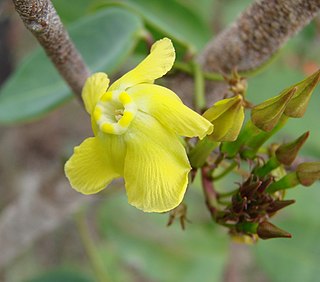
Prestonia is a genus of plants in the family Apocynaceae, first described as a genus in 1810. It is native to Mexico, Central America, South America, and the West Indies. It is closely related to Artia and Parsonsia.

Echites panduratus is a climbing vine with edible flowers, widespread in El Salvador, Guatemala, and other countries in Central America as well as parts of Mexico. The name "loroco" is used throughout Mesoamerica to refer to the species.

Crusea is a genus of angiosperms in the family Rubiaceae. The genus is found in the south-western United States, Mexico, and Central America. A few species are naturalized in Cuba and Puerto Rico.
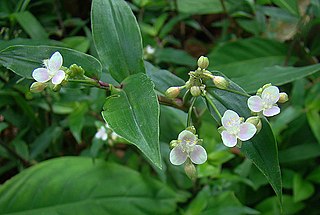
Tripogandra is a genus of flowering plants in the spiderwort family, Commelinaceae. It is native to the Western Hemisphere from central Mexico and the West Indies south to Argentina.
Pinochia is a genus of plants in the family Apocynaceae, first described as a genus in 2007. It is native to Central America, Mexico, and the West Indies.

Lacmellea is a genus of flowering plants in the family Apocynaceae first described as a genus in 1857. It is native to South America and Central America.
- Lacmellea abbreviataJ.F.Morales - Colombia
- Lacmellea aculeata(Ducke) Monach - Peru, NW Brazil, the Guianas
- Lacmellea arborescens(Müll.Arg.) Markgr. - Brazil, Bolivia
- Lacmellea bahiensisJ.F.Morales - Bahia
- Lacmellea costanensisSteyerm. - N Venezuela
- Lacmellea densifoliata(Ducke) Markgr. - Pará
- Lacmellea edulisH.Karst. - Panama, Venezuela, Colombia, Ecuador, Peru, Brazil
- Lacmellea floribunda(Poepp.) Benth. & Hook.f. - Peru, NW Brazil, Suriname, French Guiana
- Lacmellea foxii(Stapf) Markgr. - Peru
- Lacmellea gracilis(Müll.Arg.) Markgr. - N Peru, NW Brazil
- Lacmellea guyanensis(Müll.Arg.) Monach - French Guiana
- Lacmellea klugiiMonach. - Peru
- Lacmellea macranthaJ.F.Morales - Ecuador
- Lacmellea microcarpa(Müll.Arg.) Markgr. - Colombia, S Venezuela, NW Brazil
- Lacmellea oblongataMarkgr. - SE Colombia, Ecuador, Peru
- Lacmellea panamensis(Woodson) Markgr. - Costa Rica, Panama, Colombia, Ecuador
- Lacmellea pauciflora(Kuhlm.) Markgr. - Brazil
- Lacmellea peruviana(Van Heurck & Müll.Arg.) Markgr. - Peru
- Lacmellea pygmaeaMonach. - Amazonas State in Venezuela
- Lacmellea ramosissima(Müll.Arg.) Markgr. - Colombia, S Venezuela, NW Brazil
- Lacmellea speciosaWoodson - Costa Rica, Panama, Colombia, Ecuador, Peru
- Lacmellea standleyi(Woodson) Monach. - Belize, Guatemala, Honduras
- Lacmellea utilis(Arn.) Markgr. - S Venezuela, Guyana
- Lacmellea zamoraeJ.F.Morales - Costa Rica
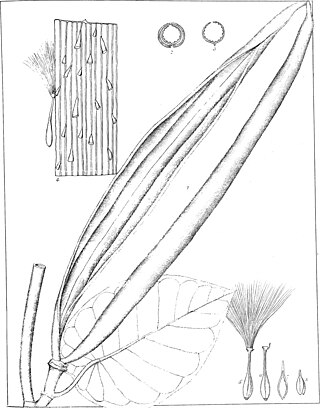
Macropharynx is a genus of plants in the family Apocynaceae, first described as a genus in 1927. It is native to South America and Central America.
Mortoniella is a monotypic genus of flowering plants in the family Apocynaceae, first described as a genus in 1939. It contains only one known species, Mortoniella pittieri, native to Central America.
Tintinnabularia is a genus of flowering plants in the family Apocynaceae, first described for modern science as a genus in 1936. It is native to S Mexico, Guatemala, and Honduras.
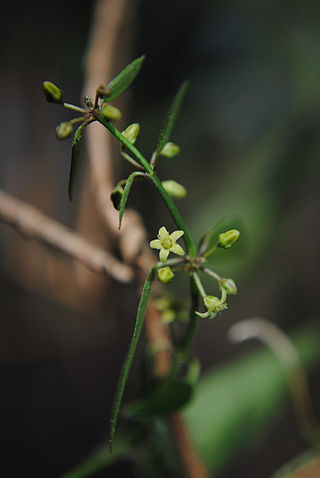
Orthosia is a genus of plants in the family Apocynaceae, first described as a genus in 1844.
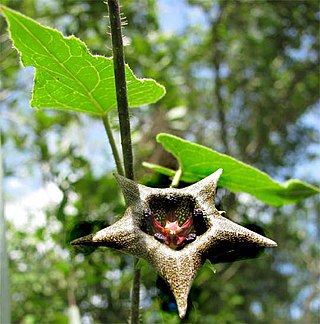
Dictyanthus is a genus of plant in family Apocynaceae, first described as a genus in 1844. It is native to Mexico and Central America.














